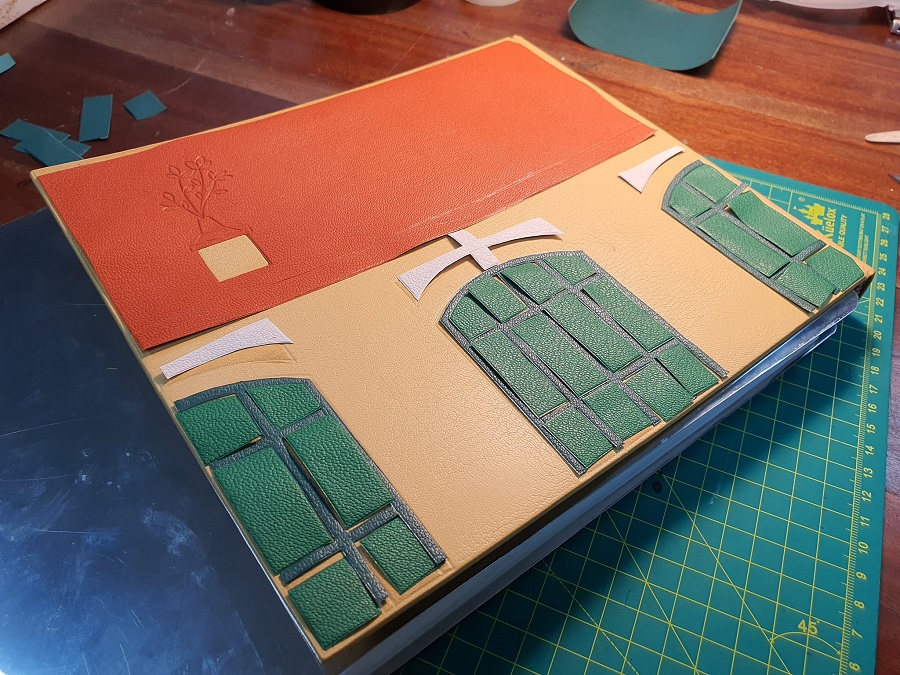Young Hanoian keeps traditional craft of bookbinding alive
Young artisans of the X generation strive to elevate traditional bookbinding into an art form.
Exquisitely crafted covers of goatskin not only enhance the beauty of precious books but also help preserve the “human quintessence” for the next generations of book lovers in Vietnam.
A Vietnamese talent
| The portrait of the young talented Vietnamese bookbinder. Photo: Tran Trung Hieu |
With the desire to preserve bookbinding in Vietnam, Tran Trung Hieu (24 years old, Cau Giay District, Hanoi) has taught himself how to create books with his own mark, which fascinates many people.
In the era of Industry 4.0 technologies, a number of traditional handicrafts in Vietnam have fallen into oblivion. Bookbinding appeared in the country more than 1,500 years ago, yet has not been widely known and maintained. Realizing the excitement coming from a new craft, the young man has learned it on his own and created works that caught the attention of viewers.
“In fact, bookbinding is not a traditional craft originating in Vietnam, but in European and Middle Eastern countries, so relevant documents or trainers in our country are very rare. However, it is those difficulties that stimulate my curiosity, and I really want to bring bookbinding closer to everyone,” Hieu shared.
In the early days of learning the new handicraft, Hieu encountered many challenges. The young man said that his experience in bookbinding was accumulated through his own practice.
“It took me two years to complete a notebook as I wanted. When I first started, I didn't have any documents, trainers, or tools of any kind. Fortunately, my language skills are enough for me to understand foreign instructions and tinker around with books,” he said.
| A work by the bookbinder. Photo: Tran Trung Hieu |
According to Hieu, a complete assembling of a book requires undergoing five main stages, including assessing the book to be rebound (condition, specifications, binding method), unbinding it, creating its new structure, wrapping it in a new cover, and decorating it.
The main material for the craft is goatskin. It also requires a lot of tools: bone folders, large-sized awls, chisels, needles, threads, paper knives, hammers, mushroom punch board, scissors, glue brush, among others.
The guy in his 30s said that he could complete one or two stages every day. A normal book takes about a week, whereas more complex ones may take several or even months to finish.
As an enthusiast for vintage things, having engaged in the handicraft since a freshman at the Hanoi University of Industrial Fine Arts, Hieu values the products made by his own hands, devoting all his energy and enthusiasm to bookbinding.
“For me, no book is the most special, because each book brings me different emotions. Every time when a work is finished, I will have gained a lot of experience,” he said.
Through the skillful hands of the 90’s guy with the desire to preserve knowledge forever, old books appear to have put on a new dress. For books that are over 100 years old or those of single copy, handling them requires the craftsman’s utmost patience, meticulousness and care, so as not to damage the national treasures.
| Sheepskin, materials for book cover. Photo: Tran Trung Hieu |
Despite having to overcome many challenges when approaching this rare art form, Hieu still loves his current job. For him, bookbinding is the convergence of all the fields that he loves, from art, knowledge to handicraft, and even helps him satisfy his hobby of antique hunting.
“In my opinion, young people intending to engage in bookbinding should be bold. First of all, you need to have perseverance, in addition to a sharp mind and eagerness to learn, then you will surely achieve worthy results.” Hieu shared.
As the first to lay the foundation for a new job, Hieu still hopes that one day the bookbinding industry will flourish in Vietnam. “I see that bookbinding has made a comeback in our country in recent years, probably starting with the publications of bookstores like Dong A and Nha Nam. Holding the ‘real’ book gives me the best feelings,” he remarked.
Hieu is among the first young Vietnamese to work in and preserve the craft of bookbinding in Vietnam. Nevertheless, he never intends to give up despite the rough road ahead. “I hope that bookbinding will become more popular. I also believe that young Vietnamese will soon make their marks in this field internationally,” he said.
| L'art à Hué - Léopold Cadière (Nouvelle Edition, 1930) - finished bookbinding by Hieu. Photo Tran Trung Hieu |
The history of bookbinding
According to Boo Vito J. Brenni in “Bookbinding - a guide to literature”, the history of the world’s bookbinding can begin in Egypt with educated monks as early as the sixth century, who would protect their manuscripts with wooden boards encrusted with metal and jewels.
However, modern-era bookbinding came about with the advent of the printing press. Since then, the craft of book-binding was also used to refer to the design of book covers.
For the next 200 years, innovation and exemplary bookbinding were set by the royal courts of France, followed by Germany, England, and Venice.
The industry was forced to adjust its commercial approach in the mid-nineteenth century due to competition from cheaper materials such as cloth and from new binding technologies such as gluing sheets together rather than sewing.















